Abstract
Monocyte/macrophages are professional antigen-presenting cells of the cellular immune system, serving to generate peptides for major histocompatibility complex (MHC) class II-restricted recognition by CD4+ T-lymphocyte effector cells. Antigen presentation by these cells involves the internalization of extracellular proteins and their fragmentation within vacuolar compartments. The resulting peptides become associated with MHC class II molecules. The final destination of exogenous peptide antigens, however, is not absolute in monocytes. Processed peptides, derived from exogenous proteins, can also associate with MHC class I molecules. To study simultaneous presentation of peptides derived from exogenous and endogenous proteins by human leucocyte antigen (HLA) class I molecules, we isolated the peptides from a human immunodeficiency virus nef transfected U937 monocytic cell line. The HLA class I-bound peptides were separated by reverse phase-high performance liquid chromatography. Comparison of the peptide sequence data with protein databases revealed that the peptides derived from extracellular, as well as intracellular, proteins, suggesting that monocytes have a more generalized MHC class I antigen-processing pathway than previously documented.
Full text
PDF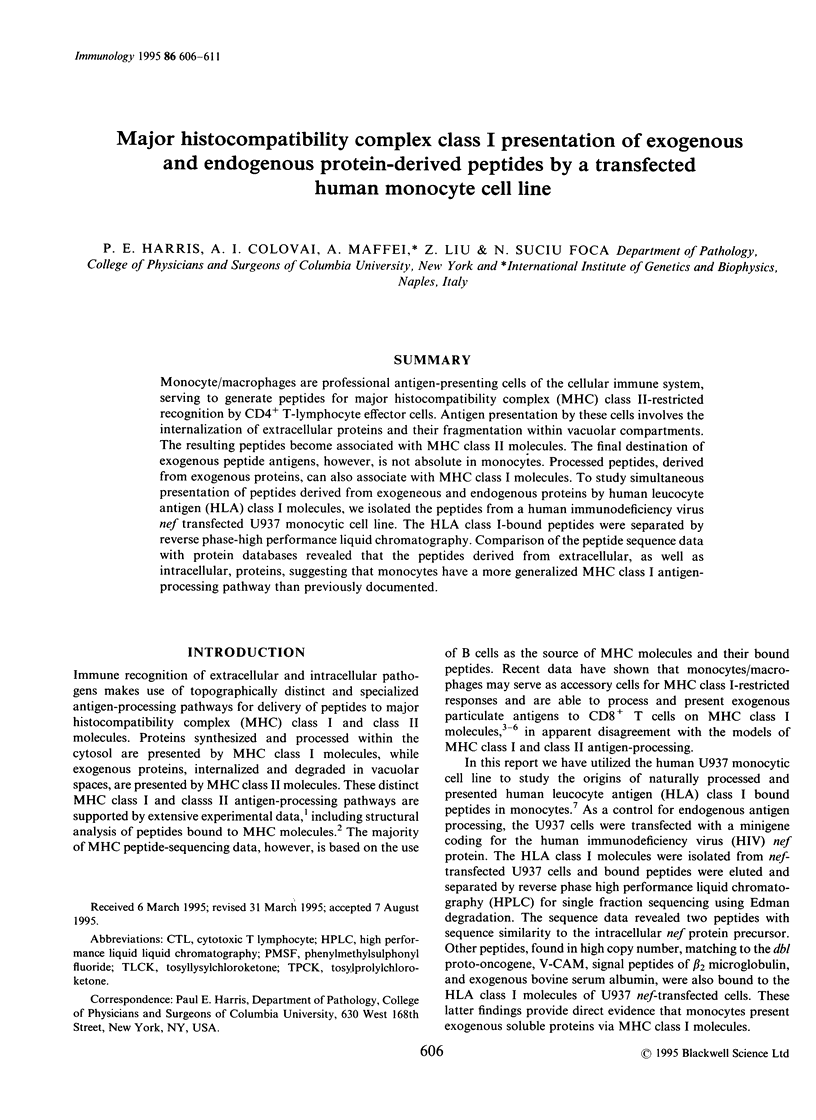
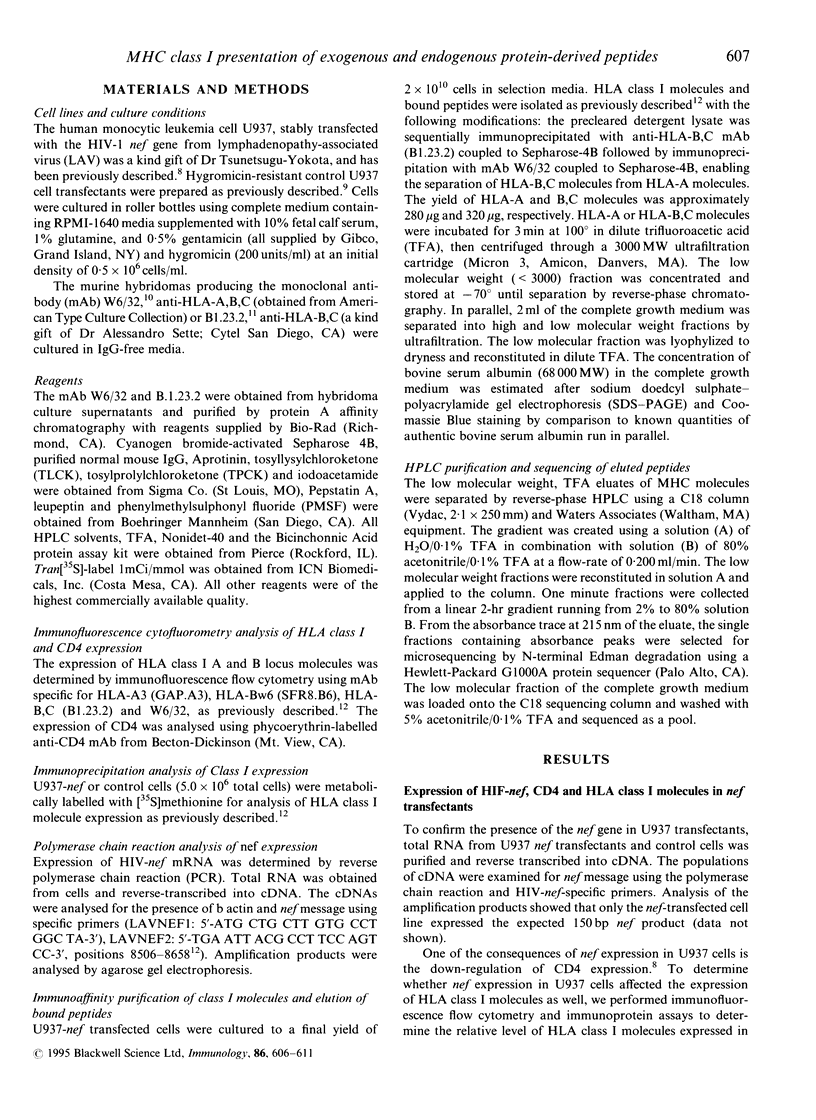
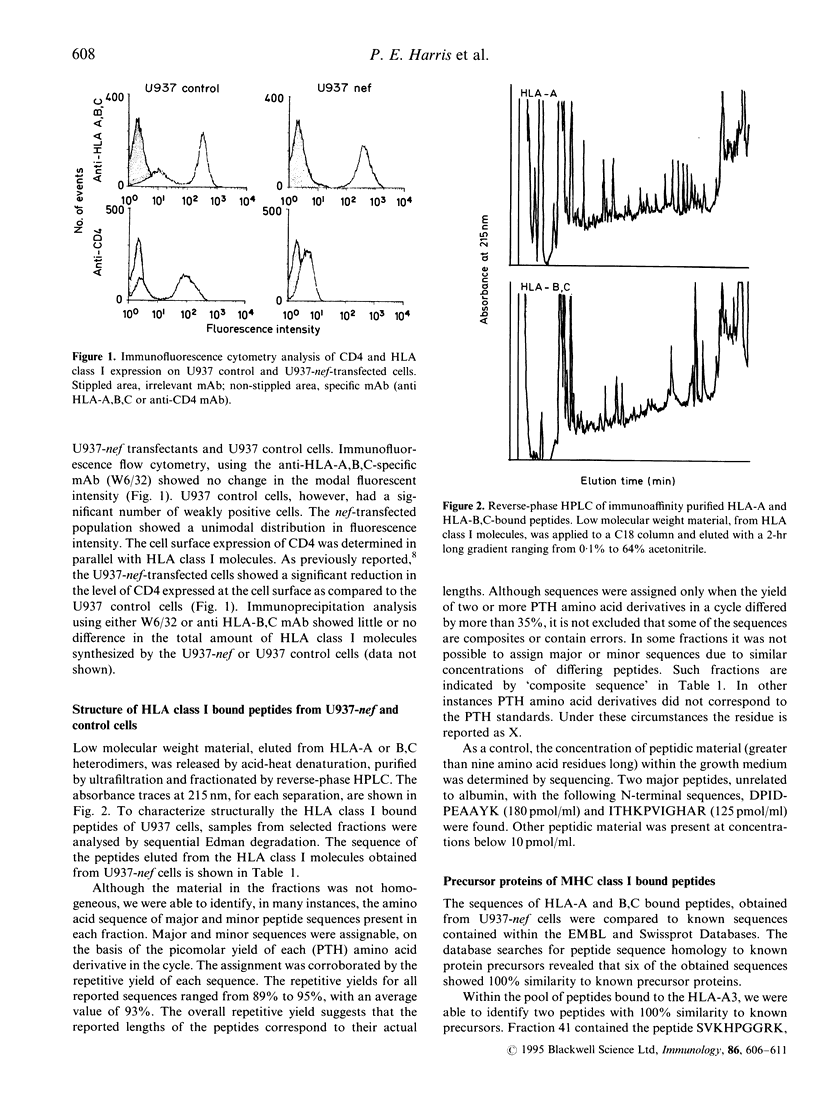
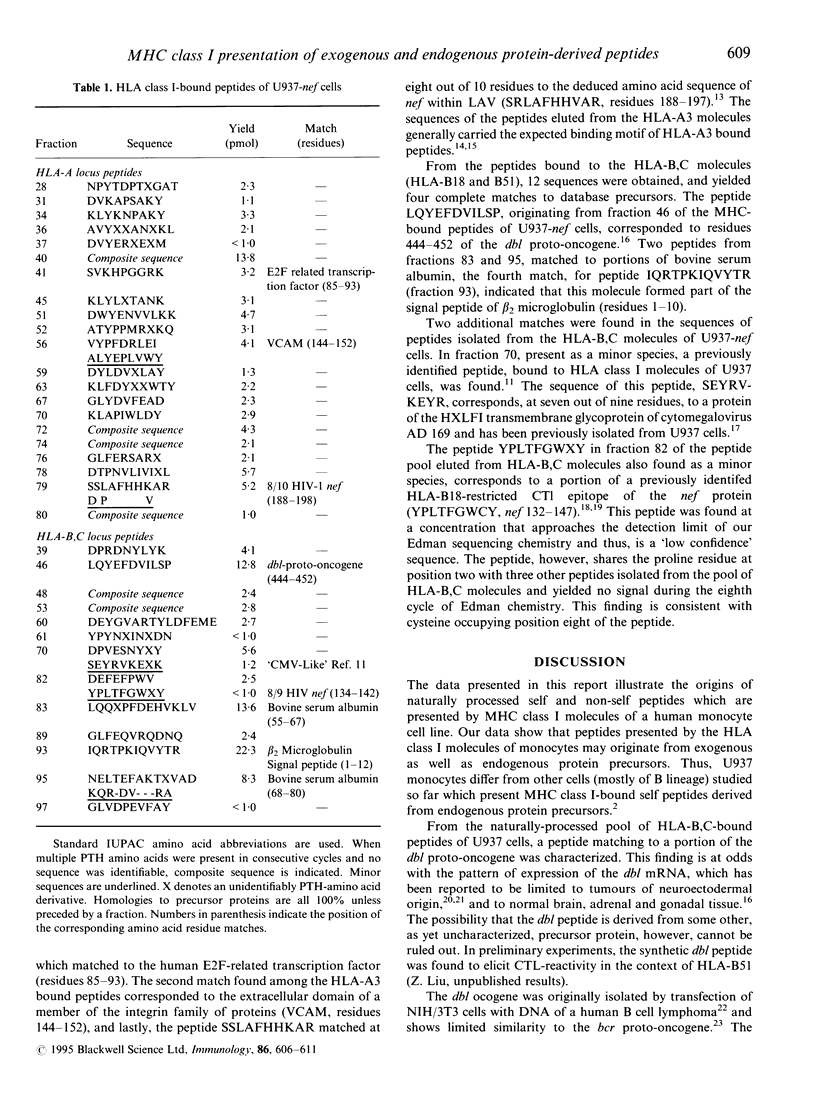
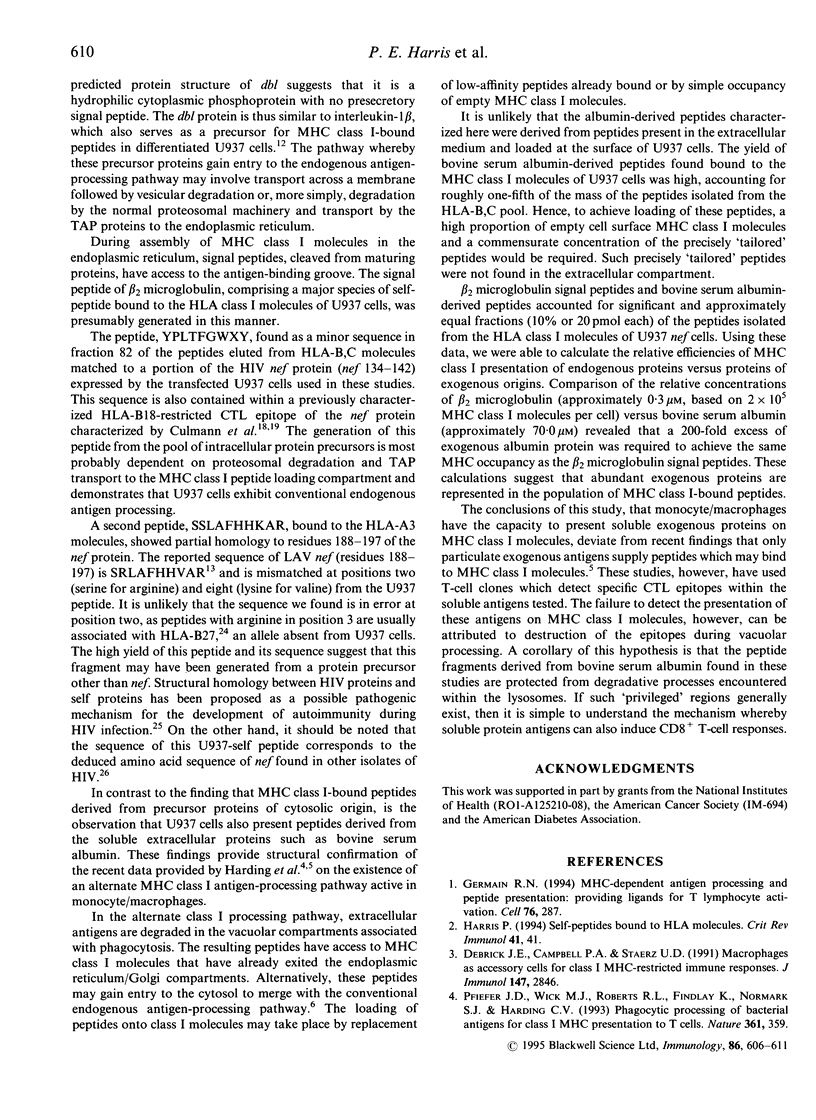
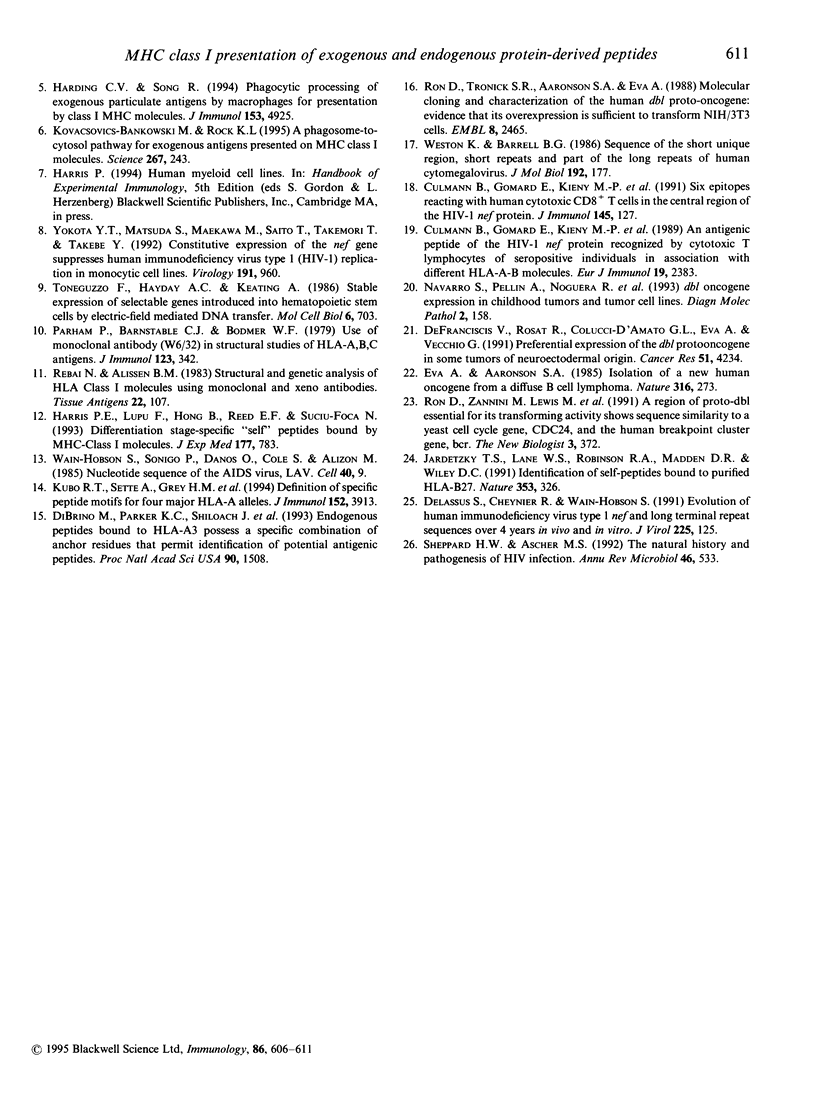
Selected References
These references are in PubMed. This may not be the complete list of references from this article.
- Culmann B., Gomard E., Kiény M. P., Guy B., Dreyfus F., Saimot A. G., Sereni D., Lévy J. P. An antigenic peptide of the HIV-1 NEF protein recognized by cytotoxic T lymphocytes of seropositive individuals in association with different HLA-B molecules. Eur J Immunol. 1989 Dec;19(12):2383–2386. doi: 10.1002/eji.1830191231. [DOI] [PubMed] [Google Scholar]
- Debrick J. E., Campbell P. A., Staerz U. D. Macrophages as accessory cells for class I MHC-restricted immune responses. J Immunol. 1991 Nov 1;147(9):2846–2851. [PubMed] [Google Scholar]
- DiBrino M., Parker K. C., Shiloach J., Knierman M., Lukszo J., Turner R. V., Biddison W. E., Coligan J. E. Endogenous peptides bound to HLA-A3 possess a specific combination of anchor residues that permit identification of potential antigenic peptides. Proc Natl Acad Sci U S A. 1993 Feb 15;90(4):1508–1512. doi: 10.1073/pnas.90.4.1508. [DOI] [PMC free article] [PubMed] [Google Scholar]
- Eva A., Aaronson S. A. Isolation of a new human oncogene from a diffuse B-cell lymphoma. Nature. 1985 Jul 18;316(6025):273–275. doi: 10.1038/316273a0. [DOI] [PubMed] [Google Scholar]
- Germain R. N. MHC-dependent antigen processing and peptide presentation: providing ligands for T lymphocyte activation. Cell. 1994 Jan 28;76(2):287–299. doi: 10.1016/0092-8674(94)90336-0. [DOI] [PubMed] [Google Scholar]
- Harding C. V., Song R. Phagocytic processing of exogenous particulate antigens by macrophages for presentation by class I MHC molecules. J Immunol. 1994 Dec 1;153(11):4925–4933. [PubMed] [Google Scholar]
- Harris P. E., Lupu F., Hong B., Reed E. F., Suciu-Foca N. Differentiation-stage specific self-peptides bound by major histocompatibility complex class I molecules. J Exp Med. 1993 Mar 1;177(3):783–790. doi: 10.1084/jem.177.3.783. [DOI] [PMC free article] [PubMed] [Google Scholar]
- Jardetzky T. S., Lane W. S., Robinson R. A., Madden D. R., Wiley D. C. Identification of self peptides bound to purified HLA-B27. Nature. 1991 Sep 26;353(6342):326–329. doi: 10.1038/353326a0. [DOI] [PubMed] [Google Scholar]
- Kovacsovics-Bankowski M., Rock K. L. A phagosome-to-cytosol pathway for exogenous antigens presented on MHC class I molecules. Science. 1995 Jan 13;267(5195):243–246. doi: 10.1126/science.7809629. [DOI] [PubMed] [Google Scholar]
- Kubo R. T., Sette A., Grey H. M., Appella E., Sakaguchi K., Zhu N. Z., Arnott D., Sherman N., Shabanowitz J., Michel H. Definition of specific peptide motifs for four major HLA-A alleles. J Immunol. 1994 Apr 15;152(8):3913–3924. [PubMed] [Google Scholar]
- Navarro S., Pellín A., Noguera R., Díaz M. P., Tsokos M., Triche T. J., Llombart-Bosch A. dbl oncogene expression in childhood tumors and tumor cell lines. Diagn Mol Pathol. 1993 Sep;2(3):158–162. [PubMed] [Google Scholar]
- Parham P., Barnstable C. J., Bodmer W. F. Use of a monoclonal antibody (W6/32) in structural studies of HLA-A,B,C, antigens. J Immunol. 1979 Jul;123(1):342–349. [PubMed] [Google Scholar]
- Pfeifer J. D., Wick M. J., Roberts R. L., Findlay K., Normark S. J., Harding C. V. Phagocytic processing of bacterial antigens for class I MHC presentation to T cells. Nature. 1993 Jan 28;361(6410):359–362. doi: 10.1038/361359a0. [DOI] [PubMed] [Google Scholar]
- Rebaï N., Malissen B. Structural and genetic analyses of HLA class I molecules using monoclonal xenoantibodies. Tissue Antigens. 1983 Aug;22(2):107–117. doi: 10.1111/j.1399-0039.1983.tb01176.x. [DOI] [PubMed] [Google Scholar]
- Ron D., Tronick S. R., Aaronson S. A., Eva A. Molecular cloning and characterization of the human dbl proto-oncogene: evidence that its overexpression is sufficient to transform NIH/3T3 cells. EMBO J. 1988 Aug;7(8):2465–2473. doi: 10.1002/j.1460-2075.1988.tb03093.x. [DOI] [PMC free article] [PubMed] [Google Scholar]
- Ron D., Zannini M., Lewis M., Wickner R. B., Hunt L. T., Graziani G., Tronick S. R., Aaronson S. A., Eva A. A region of proto-dbl essential for its transforming activity shows sequence similarity to a yeast cell cycle gene, CDC24, and the human breakpoint cluster gene, bcr. New Biol. 1991 Apr;3(4):372–379. [PubMed] [Google Scholar]
- Sheppard H. W., Ascher M. S. The natural history and pathogenesis of HIV infection. Annu Rev Microbiol. 1992;46:533–564. doi: 10.1146/annurev.mi.46.100192.002533. [DOI] [PubMed] [Google Scholar]
- Toneguzzo F., Hayday A. C., Keating A. Electric field-mediated DNA transfer: transient and stable gene expression in human and mouse lymphoid cells. Mol Cell Biol. 1986 Feb;6(2):703–706. doi: 10.1128/mcb.6.2.703. [DOI] [PMC free article] [PubMed] [Google Scholar]
- Tsunetsugu-Yokota Y., Matsuda S., Maekawa M., Saito T., Takemori T., Takebe Y. Constitutive expression of the nef gene suppresses human immunodeficiency virus type 1 (HIV-1) replication in monocytic cell lines. Virology. 1992 Dec;191(2):960–963. doi: 10.1016/0042-6822(92)90272-q. [DOI] [PubMed] [Google Scholar]
- Weston K., Barrell B. G. Sequence of the short unique region, short repeats, and part of the long repeats of human cytomegalovirus. J Mol Biol. 1986 Nov 20;192(2):177–208. doi: 10.1016/0022-2836(86)90359-1. [DOI] [PubMed] [Google Scholar]
- de Franciscis V., Rosati R., Colucci-D'Amato G. L., Eva A., Vecchio G. Preferential expression of the dbl protooncogene in some tumors of neuroectodermal origin. Cancer Res. 1991 Aug 15;51(16):4234–4237. [PubMed] [Google Scholar]


